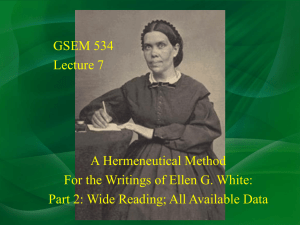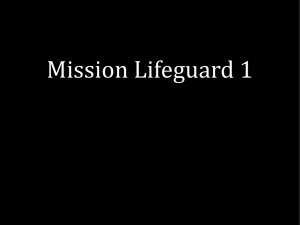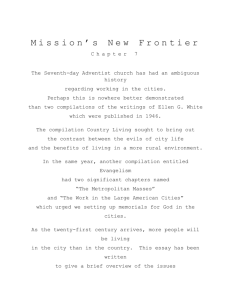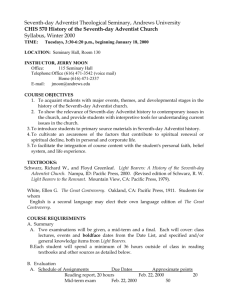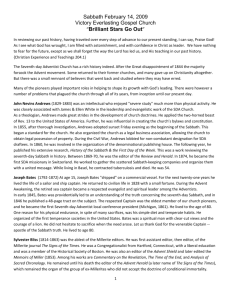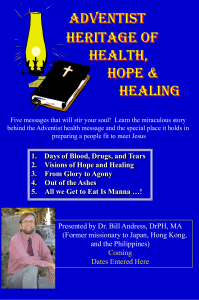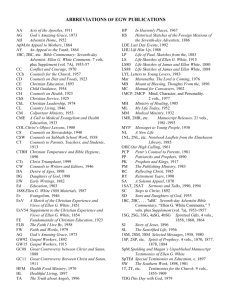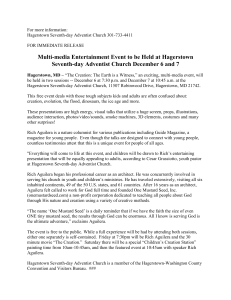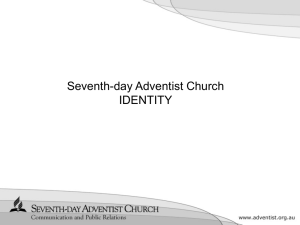Advent Pioneers Gallery
advertisement
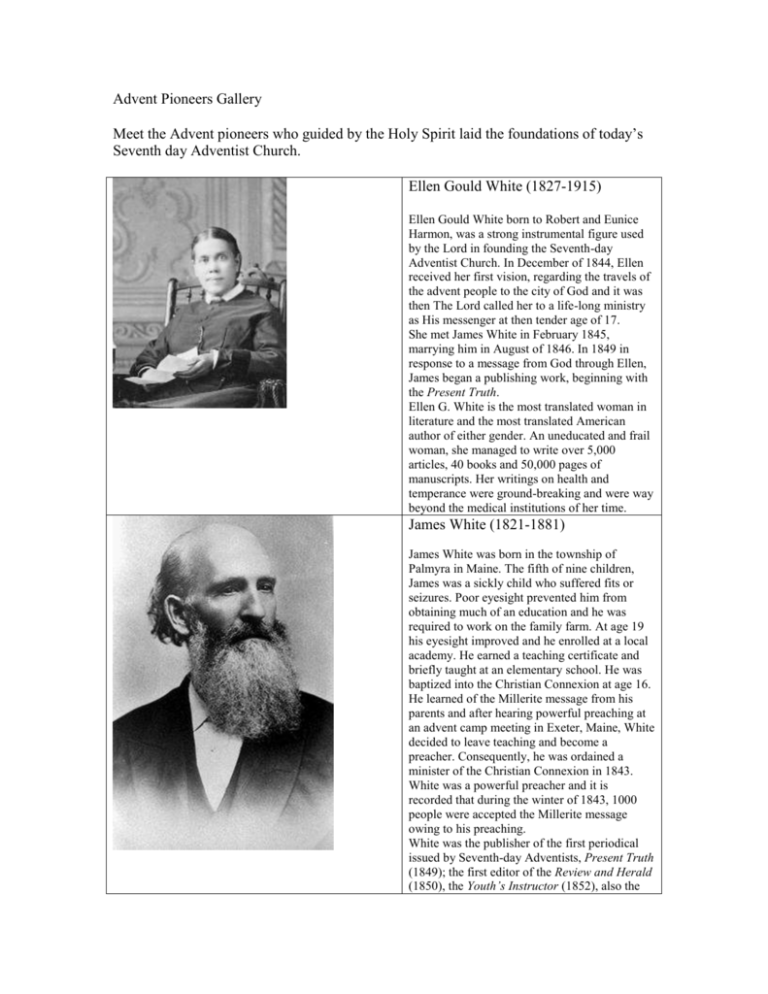
Advent Pioneers Gallery Meet the Advent pioneers who guided by the Holy Spirit laid the foundations of today’s Seventh day Adventist Church. Ellen Gould White (1827-1915) Ellen Gould White born to Robert and Eunice Harmon, was a strong instrumental figure used by the Lord in founding the Seventh-day Adventist Church. In December of 1844, Ellen received her first vision, regarding the travels of the advent people to the city of God and it was then The Lord called her to a life-long ministry as His messenger at then tender age of 17. She met James White in February 1845, marrying him in August of 1846. In 1849 in response to a message from God through Ellen, James began a publishing work, beginning with the Present Truth. Ellen G. White is the most translated woman in literature and the most translated American author of either gender. An uneducated and frail woman, she managed to write over 5,000 articles, 40 books and 50,000 pages of manuscripts. Her writings on health and temperance were ground-breaking and were way beyond the medical institutions of her time. James White (1821-1881) James White was born in the township of Palmyra in Maine. The fifth of nine children, James was a sickly child who suffered fits or seizures. Poor eyesight prevented him from obtaining much of an education and he was required to work on the family farm. At age 19 his eyesight improved and he enrolled at a local academy. He earned a teaching certificate and briefly taught at an elementary school. He was baptized into the Christian Connexion at age 16. He learned of the Millerite message from his parents and after hearing powerful preaching at an advent camp meeting in Exeter, Maine, White decided to leave teaching and become a preacher. Consequently, he was ordained a minister of the Christian Connexion in 1843. White was a powerful preacher and it is recorded that during the winter of 1843, 1000 people were accepted the Millerite message owing to his preaching. White was the publisher of the first periodical issued by Seventh-day Adventists, Present Truth (1849); the first editor of the Review and Herald (1850), the Youth’s Instructor (1852), also the Signs of the Times (1874). He was president of the General Conference between 1865-1967, 1869-1871, and 1874-1880. If there was a founder of the Review and Herald Publishing Association, it was James White along with his wife, Ellen. He was the sponsor and promoter of the Pacific Press Publishing Association. He died August 6, 1881, when he was only sixty. He literally worked himself to death. The brethren leaned on him so heavily that his towering figure fell. His sixty years of life were spent unselfishly and sacrificially. No other Seventh-day Adventist minister did more than he to build high principle and efficiency into the life of our churches and institutions. William Miller 1782-1849 William Miller had a strong religious background, but he became attached to the wrong "crowd". He set aside the Bible and had vague ideas about God and His personality. When Miller was thirty-four the Holy Spirit impressed his heart, and he turned to the study of the Word of God. He found in Christ the answer to all his needs. His study led him to the great prophecies that pointed to the first and to the second advent of our Lord. The time prophecies interested him, particularly the prophecies of Daniel and The Revelation. In the year 1818, as a result of his study of the prophecies of Daniel 8 and 9, he came to the conclusion that Christ would come some time in the year 1843 or 1844. He hesitated until 1831 before he began to announce his findings. From his first public service we may mark the beginnings of the Advent movement in North America. In the months and years that followed, roughly 100,000 persons came to believe in the imminence of Christ's second coming. Following the great disappointment of 1844, Miller lived for several years before He fell asleep in Christ in 1849. In spite of his misunderstanding of the event that was to transpire in 1844, God used him to awaken the world to the nearness of the end and to prepare sinners for the time of judgment Joseph Bates (1792 - 1872) Joseph Bates was born in Rochester, Massachusetts on July 8, 1792. In 1810 Bates was forced into servitude for the British navy and spent time as a prisoner during the War of 1812. After his release he continued his career eventually becoming captain of a ship. During one of his voyages he read a copy of the Bible that his wife packed for him. He experienced conversion and became involved in a variety of reforms including helping to found an early temperance society. In 1839 he accepted the teachings of William Miller that Jesus was coming soon. After October 22, 1844, like many other Millerites, Bates sought meaning out of the Great Disappointment. During the spring of 1845 Bates accepted the seventh-day Sabbath after reading a pamphlet by T. M. Preble. Bates soon became known as the "apostle of the Sabbath" and wrote several booklets on the topic. One of the first, published in 1846, was entitled The Seventh Day Sabbath, a Perpetual Sign.[3] One of Bates' most significant contribution was his ability to connect theologically the Sabbath with a unique understanding of the heavenly sanctuary. This apocalyptic understanding of theology would become known as the Great Controversy theme. Joseph Bates was a strong supporter of James White and the prophetic gift, which he believed was manifested in visions received by the young Ellen G. White. He contributed to early publications such as A Word to the "Little Flock." Joseph Bates passed to his rest on March 19, 1872 in Battle Creek, Michigan and is buried in a cemetery in Monterey, Michigan. Uriah Smith (1832 Born in 1832 in West Wilton, New Hampshire. His family accepted the Millerite message and in 1844 experienced what has become known as the Great Disappointment. That same year, Smith had his left leg amputated due to an infection. Following the Disappointment. Around 1852, he became involved in the early Seventh-day Adventist Church. In 1853, he began working at the offices of the Advent Review and Sabbath Herald (now the Adventist Review), becoming its editor in 1855. His main contribution to Adventist theology was a commentary on the prophetic Biblical books of Daniel and the Revelation originally called ‘Thoughts on Daniel and the Revelation) This book was greatly endorsed by Ellen White and she even referred to it as ‘God’s helping hand.’ 1843 Chart This was the 1843 chart used by the millerites to expound on the time prophecies found in Daniel and the Revelation. Regarding the 1843 Chart, Ellen White writes: “I have seen that the 1843 chart was directed by the hand of the Lord, and that it should not be altered; that the figures were as He wanted them; that His hand was over and hid a mistake in some of the figures, so that none could see it, until His hand was removed.” Early Writings P74 Hiram Edson 1806-1882 Edson spent October 22, 1844 with friends waiting for the event, and was heart-broken when Jesus did not return as expected. He later wrote: "Our fondest hopes and expectations were blasted, and such a spirit of weeping came over us as I never experienced before. It seemed that the loss of all earthly friends could have been no comparison. We wept, and wept, till the day dawn." On the morning of October 23 they were passing through Edson's grain field where he had a vision. In this vision, Edson came to understand that "the cleansing of the sanctuary" meant that Jesus was moving from the Holy Place to the Most Holy Place in the heavenly sanctuary, and not to the Second Coming of Jesus to earth: "We started, and while passing through a large field I was stopped about midway of the field. Heaven seemed opened to my view, and I saw distinctly and clearly that instead of our High Priest coming out of the Most Holy of the heavenly sanctuary to come to this earth on the tenth day of the seventh month, at the end of the 2300 days, He for the first time entered on that day the second apartment of that sanctuary; and that He had a work to perform in the Most Holy before coming to the earth." Edson shared what he believed he saw with many of the local Adventists who were greatly encouraged by his account. As a result Edson began studying the bible with two of the other believers in the area, O. R. L. Crosier and Franklin B. Hahn, who published their findings in a paper called the Day-Dawn. This paper explored the biblical parable of the Ten Virgins. Charles Fitch (1805-1844) In 1842, feeling the need of an accurate chart, Fitch and Apollos Hale prepared the famous chart illustrating the fulfillment of the last-time prophecies of Daniel. This was used extensively by the Millerites. Fitch himself used this chart and also other visual aids including a replica of the Daniel 2 statue that could be separated into its various parts. Charles Fitch became seriously ill, probably with pneumonia, in the month of October, 1844. He had chilled while baptizing converts. He died on Monday, October 14th, in full faith that he should awake in a few days in the likeness of his Redeemer. Josiah Litch (1809-1886) Dr. Josiah Litch, a 19th Century physician and itinerant minister for the Methodist Episcopal Church, accurately predicted two years in advance, the fall of the Ottoman Empire in August of 1840 (a formidable alliance of Arab nations governed from Turkey). This was an exact fulfillment of Bible prophecy in "Revelation" chapter nine. Continuing his research, two months before the event he predicted the exact day, August 11, 1840, and it was widely circulated in Christian journals and newspapers. This prediction brought thousands to the fold and the message of Christ s coming was widely circulates. Stephen N. Haskell (1833-1922) Stephen N. Haskell was an evangelist and administrator. He began preaching for the nonSabbath keeping Adventists in New England in 1853. Later that year he began to worship on Saturday, or Sabbath. He worked without pay in New England until his ordination in 1870. He was president of Seventh-day Adventist churches in various parts of the United States. In 1885 he led a group of missionaries who began to spread the Adventist mission in Australia and New Zealand. In 1887 he began to establish the Adventist church in London, England. He travelled the world as a missionary between 1889 and 1890, visiting Western Europe, Southern Africa, India, China, Japan, and Australia. Haskell is also remembered as the person who organised the first Adventist Church of African Americans in New York City in 1902. He led in temperance work in Maine in 1911, began printing books for the blind in 1912, and assisted in the development of the White Memorial Hospital in 1916. He wrote: "The Story of Daniel the Prophet", "The Story of the Seer of Patmos", and "The Cross and Its Shadow". John Norton Loughborough 1832-1924 John is well known for writing the books The Rise and Progress of Seventh-day Adventists and The Great Second Advent Movement. Like most of the early Advent leaders, Loughborough took a real interest in the literature work. He and James White discussed ways and means of advancing the work of the gospel. It was suggested that if books were offered to the public in connection with preaching services, the people would be willing to pay a small price for them. Thus, the way would be prepared for more literature to be produced. Young Loughborough tried this method, and it was a success.Loughborough spent his last years in the St. Helena Sanitarium, where he passed away peacefully on April 7, 1924, at the ripe old age of ninety-two John Nevins Andrews 1829-1883 A Seventh-day Adventist minister, missionary, writer, editor, and scholar. Born in Poland, Maine in 1829, Andrews was converted in February 1843 and began to observe the seventh-day Sabbath in 1845. He met James White and Ellen G. White in September 1849. Later, the Whites boarded with the Andrews family. In 1850 he began itinerant pastoral ministry in New England and ordained in 1853. Andrews played a pivotal role in the establishment of Adventist theology. Alonzo T. Jones 1850-1923 Alonzo was baptized when he left the Army, and began preaching on the West Coast. In May, 1885, he became editor of the Signs of the Times, and was later joined by E. J. Waggoner. In 1888, these two men stirred the General Conference session in Minneapolis with their preaching on righteousness by faith. For several years thereafter, they preached on that subject from coast to coast. Ellen White accompanied them on many occasions. She saw in Jones’ presentations of "the precious subject of faith and the righteousness of Christ...a flood of light" (EGW 1888 Materials, p. 291). Jones was on the General Conference Committee in 1897 and editor-in-chief of the Review and Herald from 1897 to 1901. In 1889, with J. O. Corliss, he spoke against a bill in the U.S. Congress on Sunday observance; the bill was defeated. Thereafter he was a prominent speaker for religious freedom, serving as editor of the forerunner of the Liberty magazine. Dr. Ellet J. Waggoner 1855-1916 In 1884 E. J. Waggoner became assistant editor of the Signs of the Times, under his father, J. H. Waggoner. Two years later, he and A. T. Jones became editors of the same journal, Waggoner remaining in the position until 1891. At the 1888 General Conference session in Minneapolis, Minnesota, he and Jones gave their famous series of sermons on righteousness by faith. In 1892 he became editor of the Present Truth, in England, where he lived until 1902. While there he conducted, with W. W. Prescott, a workers’ training school and, for a short time, was president of the South England Conference. After returning to the United States, he worked briefly on the staff of Emmanuel Missionary College. Regardless of what happened to the man, Mrs. White declared about the message, "I see the beauty of truth in the presentation of the righteousness of Christ in relation to the law as the doctor has placed it before us." MS 15, 1888. She also said, "When the Lord had given to my brethren the burden to proclaim this message, I felt inexpressively grateful to God, for I know it was the message for this time." MS. 24, 1888. Ellen G. White with group at Madison Tennessee cir. 1909; Back Row: C.C. Crisler, P.T. Magan, Minnie Hawkins, "Mother D" (Mrs. Druillard, A.E Sutherland, Sara McEnterfer; Front Row: W.C. White. Mrs. E.G. White, Mrs. J. Edson (Emma) White, J. Edson White

